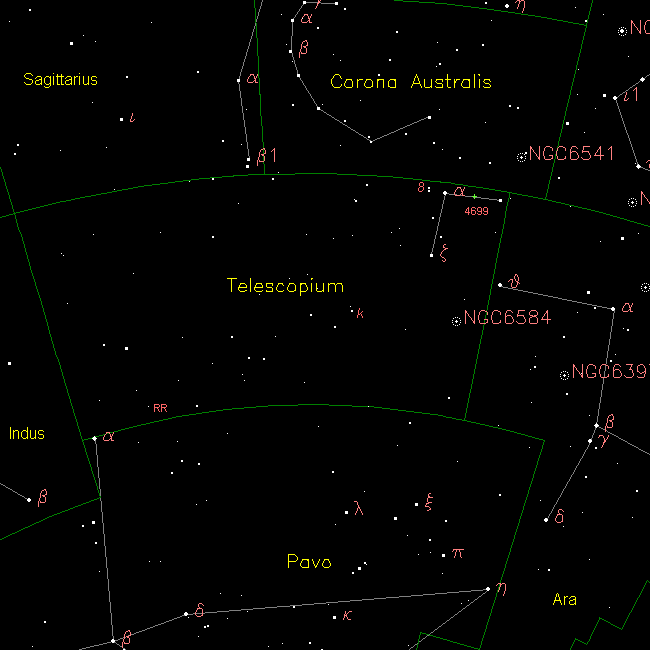[/caption]
The small constellation of Telescopium is located just south of the ecliptic plane and was originally charted by Abbe Nicolas Louis de Lacaille who named it. It was later adopted by the IAU as one of the modern 88 constellations. Telescopium spans 252 square degrees of sky – ranking 57th in size. It has 2 primary stars in its asterism and 13 Bayer Flamsteed designated stars within its confines. Telescopium is bordered by the constellations of Ara, Corona Australis, Indus, Microscopium, Pavo and Sagittarius. It is visible to observers located at latitudes between +40° and -90° and its primary stars are best seen at culmination during the month of August.
Since Telescopium is considered a “new” constellation, there is no mythology associated with it – only Abbe Nicolas Louis de Lacaille’s love of all things science and what Telescopium is meant to represent – the telescope of Sir William Herschel. In Lacaille’s time, it was called “Beta Telescopii” and when represented on Johann Bode’s charts, it pointed northwards, towards Sagittarius and Corona Australis. Since Bode actually depicted it clear up into Ophichus, he also changed the name to “Tubus Astronomicus” as well. Later, both the name – and the constellation – became more abbreviated as it was adopted by the International Astronomical Union.
Let’s begin our binocular tour of Telescopium with its brightest star – Alpha – the “a” symbol on our chart. While Alpha is far from bright to our vision, this class B (B3) blue subgiant star shines more than 900 times brighter than our own Sun from a distance of 250 light years away. It is a young star, just beginning to evolve away from a core-hydrogen-fusing dwarf. While it is rotating very slowing, Alpha is also chemically peculiar, because it is a helium rich star with very strong stellar magnetic fields. It is believed that it may someday evolve into a massive white dwarf like Sirius-B.
Now aim your binoculars towards Delta – the “8” symbol. It won’t take long to discover this designation is shared by two stars! That’s right, we’re looking at an optical double star. Delta 1 and Delta 2 are both blue-white B-type subgiant stars, but Delta 1 (slightly brighter) is approximately 800 light years from Earth, while Delta 2 is closer to 1,100 light years distant!
Are you ready for Kappa? That’s the “k” symbol on our chart. Kappa Telescopii is also a visual double star. It is a yellow G-type giant star located 293 light years from our solar system.
Get out large binoculars or a small telescope for a look at a very rare type of variable star – RR Telescopii (RA 20 04 18.54 Dec -55 43 33.2). Here we have an example of what is called a Symbiotic Nova. According to the work of F.L. Crawford: “The optical spectrum of RR Tel is very rich in emission. By comparing the results of this study with previous publications on the subject, it is found that the RR Tel system is advancing towards higher degrees of excitation. It is also shown that several nebular lines (for example, [OIII] 4363 Angstroms and NeIV 4714 Angstroms) demonstrate component structure, perhaps caused by the different densities of the emitting plasmas.” Also, infrared and optical photometric and spectroscopic observations of the symbiotic nova RR Telecopii are used to study the effects and properties of dust in symbiotic binaries containing a cool Mira component, as well as showing “obscuration events” of increased absorption, which are typical for such Mira-type variable stars. RR Telescopii erupted in 1944 and took nearly 1600 days to reach maximum. At its lowest, RR can be as dim as magnitude 11 – or as bright as magnitude 7!
Keep a telescope handy to have a look at globular cluster NGC 6584 (RA 18 : 18.6 Dec -52 : 13). At around magnitude 9, this 8 arc minute sized globular will delight you. Discovered by James Dunlop on June 5, 1826 and cataloged originally as Dunlop 376, you will pull a lot of nice resolution out of the core region with larger aperture. A lot of photometry work has been done on this particular star cluster – looking for calcium abundances, blue straggler stars and hot stars located in the galactic halo region.
Now aim your large telescope towards challenging planetary nebula IC 4699 (RA 18 : 18.5 Dec -45 : 59) At magnitude 12 and nearly stellar in size, this particular planetary nebula will be difficult to distinguish from the field without the aid of a nebula filter which will aid in revealing the small disc.

